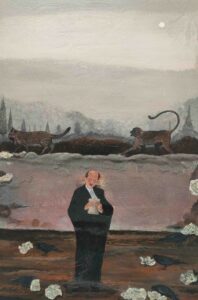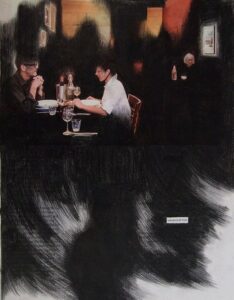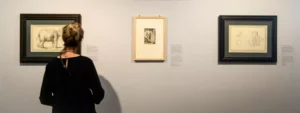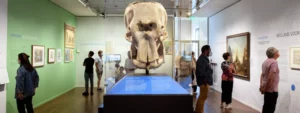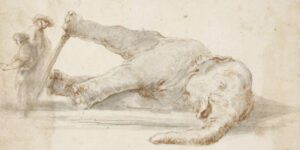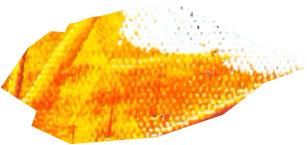In October 2023, we launched the ‘Rembrandt of the neighbourhood’ project. Young Amsterdammers aged between 16 and 24 learned more about and from Rembrandt and Sumibu, at three locations in Amsterdam: districts Noord, Zuidoost and Nieuw-West. This was reflected in self-made etchings and then T-shirt designs. Each design has its own personal story. All etching designs hang in the museum’s Open Studio until 4 February. Georgy Dendoe, founder Sumibu, chose a winner from each district of the city – their etchings have been given an extra-large frame and can only be bought as T-shirt designs in the Museum shop. Proceeds from the T-Shirts will go towards the next edition of this project.
Directed by: Rembrandt
Rembrandt as director in the spotlights
|
Rembrandt was a master storyteller, not with words but with images. To tell stories, he made use of techniques that were also used in the theatre, such as facial expressions, gestures, lighting, costumes, and accessories. In addition, he chose the best moment to depict: the moment of greatest tension, of ultimate suspense. The exhibition Directed by: Rembrandt highlights, for the first time, Rembrandt’s role as a director of his own artworks. And it reveals how 17th-century painters and theatre-makers were inspired by each other. |
A number of masterpieces are coming to Museum Rembrandthuis for the exhibition, from the Staatliche Museen zu Berlin, Mauritshuis and The Kremer Collection, among others.
Seven Directing Techniques |
 |
|
Just like theatre directors, Rembrandt manipulated all elements in his artworks at his discretion, aiming to depict a story as captivatingly and convincingly as possible. The main directing techniques he used are:
A painter can use the expression on a figure’s face to tell an important part of a story. For this, Rembrandt studied actors in the theatre. He also acted himself in front of the mirror in his studio. |
The Scandal |
|
The biblical character Susanna is about to take a bath. Two important men, elders, spy on her from the bushes. They whisper that they want to have sex with her. Susanna is startled. Rembrandt shows the ‘peripety’ of the moment: the turning point in the story is represented by Susanna turning away. Her eyes meet ours, and through that gaze, Rembrandt involves us in her predicament. The directing here is masterful because it does not get much more uncomfortable than this.
Terrible lie |
|
|
This painting is about a terrible lie. On the right is Potiphar, a courtier to the pharaoh. He listens to his wife telling him that she was almost raped by Joseph. In reality, however, she herself accosted him. The shock on the face of Joseph–on the left–speaks volumes. In the Bible story, Joseph is not featured in this scene, but Rembrandt, as director of his own story, added him to clarify that a great injustice is being done. This painting was created by Rembrandt in the Rembrandt House and is returning for the first time to the place where it was made almost 400 years ago. |
The Perfect Turban |
|
|
According to several of Rembrandt’s pupils, he could spend two days winding a turban. Apparently, he took time to assemble various parts of a costume before beginning to paint or draw them. He probably took similar care to prepare this study of an old man. Rembrandt made this study in preparation for depicting the high priests in his painting Judas Repentant (1629). He wanted to know exactly how the light falls on the back of the head of a man wearing a turban. |
Four stories, One image |
|
|
Usually, artworks depict a single moment, a single scene. This is the same in theatre, where the unity of time, place, and action is a golden rule. But, in this etching, Rembrandt brought together four moments from a single Bible story as if they had taken place at the same time. Like a director, he placed his figures in a well-balanced troep (group), alternated their height (sprong), and added plenty of verscheydenheydt (variety). The image is also full of drama and reminds us of the tableaux vivants that were popular in the Schouwburg theatre. |
Exhibition at the Stadsarchief Amsterdam
Concurrently with the exhibition Regie: Rembrandt, the Stadsarchief Amsterdam is organising a treasury exhibition highlighting the broader context of the Amsterdam Schouwburg, its playwrights and actors, and its role in the city.
The exhibition Directed by: Rembrandt will take place from 2 March to 26 May 2024 at Museum Rembrandthuis.
|
With thanks to: Mastercard, het Cultuurfonds, Rijksdienst voor het Cultureel Erfgoed, Huysgenoten van Museum Rembrandthuis, Kikkoman, Blockbusterfonds: Extra, Vrienden van Museum het Rembrandthuis, De Gijselaar-Hintzenfonds. |
Rembrandt’s Peacocks
01.07.23- 15.10.23
Rembrandt painted two peacocks – dead peacocks to be specific. It is a very special work of art. There is only a single other painting by him in which a dead bird plays the leading role (The Bittern Hunter, 1639). The picture with the peacocks has the character of a decorative piece, a work of art meant to enliven an interior. These were often hung up high, for example above a door. Peacocks are suitable subject matter for such a decorative piece, because it conjures the atmosphere of the countryside.
Coincidence or not, Rembrandt painted the peacocks around the time that he came to live in this house on the Jodenbreestraat. Perhaps he even made it for his own new house. In this way he could bring a piece of idyllic country life into his residence in the busy city.
In the multimedia tour you can find two ways of looking at and experiencing Rembrandts Still Life with Peacocks, much like a guided meditation.
The Poor Man’s Rembrandt Project
Van 17 t/m 25 juni 2023 houden Henk Schiffmacher en zijn tatoeëerders atelier bij Rembrandt thuis. Gedurende een week kun je een originele Rembrandt-tattoo laten zetten door het wereldberoemde team.
Wil je zeker zijn van een meesterwerk? Reserveer dan nu een tijdslot bij je favoriete tattoo artist via rembrandthuis.nl.
Rembrandt Forever
Rembrandt en Schiffmacher & Veldhoen hebben veel gemeen: ze zijn wereldberoemd, grootmeesters in hun vak en diepgeworteld in het DNA van Amsterdam. Ook hun kunst kent belangrijke overeenkomsten: bij zowel etsen als tatoeages begint het met een tekening, die vervolgens met inkt en naald op het medium wordt aangebracht. Waar Rembrandt een koperplaat en vel papier gebruikte om zijn compositie tot een ets te maken, brengen tatoeëerders hun tekening aan op de menselijke huid; een kunstwerk dat je levenslang altijd bij je draagt.
Schiffmacher en zijn team zullen hun atelier opzetten in de moderne museumvleugel. In de zeventiende eeuw was het pand aan de Jodenbreestraat een cultural hub, waar Rembrandt, zijn assistenten en zijn leerlingen samenwerkten aan hun kunstwerken. Nu gaat een nieuwe generatie 21ste-eeuwse kunstenaars hier aan het werk. Het museum blijft zo een plek waar het bruist van vernieuwing en experiment. Tegelijkertijd wordt de eeuwenoude kunst van etsen en inkttekeningen in ere gehouden.
Meld je aan
Tijdens hun residency in Museum Rembrandthuis biedt het team van Schiffmacher & Veldhoen Tattooing een aantal tattoo-ontwerpen aan, waaronder originele etsen van Rembrandt, Rembrandts handtekening en zijn monogram. Op rembrandthuis.nl/thepoormansrembrandtproject kun je vooraf de beschikbare tatoeages bekijken. Ook kun je hier een tijdslot reserveren om de tatoeage te laten zetten in het museum. De prijzen van de tatoeages variëren van 100 tot 250 euro. Bij het reserveren wordt om een aanbetaling van 50 euro gevraagd. We houden per dag een aantal plekken beschikbaar voor spontane inloop, maar wil je zeker zijn van een plekje, reserveer dan vooraf een tijdslot. Er zijn in totaal XX tijdslots beschikbaar.
Ontmoet het team
Henk Schiffmacher is sinds 45 jaar een begrip in de tatoeagewereld. De Amsterdamse tattookoning organiseerde de eerste grote tattooconventies in Europa, publiceerde ruim 20 boeken en exposeerde in diverse musea, waaronder Musée du Quai Branly in Parijs en het Royal Ontario Museum in Toronto. Hij beschouwt de samenwerking met Museum Rembrandthuis als een hoogtepunt in zijn carrière.
Tycho Veldhoen groeide op in de kunstwereld, als jongste zoon van de bekende Amsterdamse kunstenaar Aat Veldoen. Van hem leerde hij schilderen, tekenen en etsen. Het tatoeëren werd hem bijgebracht door Henk en Louise Schiffmacher, waarna hij aan het werk ging bij verschillende tattoogrootheden in de Verenigde Staten. Sinds 16 jaar is hij officieel partner van Schiffmacher & Veldhoen Tattooing.
Rupa van Teylingen is kunstschilder en tatoeëerder. Ook hij groeide op omringd door kunst: zijn vader was schrijver, zijn stiefvader specialist op het gebied van zeventiende-eeuwse stillevens. Hij studeerde af aan de Ruud Wackers Academie in Amsterdam als klassiek tekenaar, waarna hij bij Schiffmacher en Veldhoen in leer ging. De afgelopen tien jaar is hij afwisselend in de tattooshop en in zijn eigen atelier te vinden.
Framing Rembrandt
November 4, 2023 – February 5, 2024
Rembrandt has many faces: the genius, the miller’s son, the rebel. All of these labels were pasted onto the famous artist over the centuries. In the exhibition Framing Rembrandt, The Rembrandt House Museum will take you on a journey along four centuries of imaging, through art, documents and surprising objects. Additionally, one of the exhibition rooms will be converted into a cinema, where fragments from biopics (biographical fiction films) about Rembrandt will be shown; from the earliest film from 1920 and a Nazi propaganda film from 1942, to the latest film adaptation of Rembrandt’s life made in 2006.
Rembrandt Open Studio
After a successful first edition of Rembrandt Open Studio in 2020, with artists Iriée Zamblé (1995, Amsterdam) and Timothy Voges (1993, Curacao), and this summer’s temporary tattoo studio which was run by Henk Schiffmacher (1952, Harderwijk) and Tycho Veldhoen, two contemporary artists will again work at Rembrandt’s home this autumn. Abul Hisham (1987) and Guy Vording (1985) will work in a studio in the Rembrandt House Museum for a month and a half. Hisham and Vording, just like Rembrandt himself, have their own styles and idiosyncratic views of the world. They also share Rembrandt’s talent for telling stories, managing to capture a memory, social criticism, situation, or character sketch all in a single image.
With its Rembrandt Open Studio initiative, The Rembrandt House Museum repeats its own history. Rembrandt’s house was already a creative hub back in the seventeenth century, a place where Rembrandt and his students created art every day. Now, 400 years later, artists once again have the opportunity to work in Rembrandt’s house. The studio is inside the museum: it gives visitors an opportunity to see the process of creating contemporary art up close and meet a new generation of talented makers.
Rembrandt Open Studio with Abul Hisham and Guy Vording will take place from 1 October to 15 November 2023 in The Rembrandt House Museum.
Abul Hisham:
‘Being given the opportunity to interact more with the visitors will be a new experience for me, one that I look forward to: I like to meet and talk to people and I’m happy that I’ll be able to show them my practice personally.’
Guy Vording:
‘I really believe that a residency in the Rembrandt House, immersed in its history, its residents and the public, will enhance Rembrandts’ influence on my work. I’m looking forward to this game, this interaction, like a student guided by the master.’
Abul Hisham (1987) Hisham mainly works with pastels and raw pigments on wood. In this respect, he considers Rembrandt to be a great example: Rembrandt’s method of preparation and application of paint inspires Hisham in his own artistic practice. Many of Hisham’s artworks form a series; together, they reveal a bigger picture that deals with desires, death, religion and socio-political systems. His personal memories of his life and family in India often find their way into his art. Even so, he does not reveal everything; viewers are given the freedom to personally unravel and interpret the layers of symbols and meanings. Hisham completed his master’s degree in Hyderabad, India in 2012, and has been working as a visual artist ever since. In 2021, he moved to the Netherlands to follow a study programme at the Rijksakademie voor Beeldende Kunsten (State Academy of Fine Arts), which he completed this year.
Abul Hisham, Portrait of a Lawyer, 2022
Hisham: ‘As a painter I feel a great kinship with Rembrandt’s works. I still remember how I used Rembrandt’s famous painting of Belsshazar’s Feast as a reference. I have always been fascinated by his use of colour and texture, his experiments and his compositions. It is a rare experience to be working so close to his own studio, printmaking space and the collection of his etchings. I feel that through this residency I can continue my practice, research and experiment in Rembrandt’s footsteps. Being given the opportunity to interact more with the visitors will be a new experience for me, one that I look forward to: I like to meet and talk to people and I’m happy that I’ll be able to show them my practice personally.’
Website: Rijksakademie – Abul Hisham
Guy Vording (1985) Vording is a real disciple of Rembrandt when it comes to knowing what to leave out and what to draw attention to in order to successfully convey a story. His artwork starts with American magazine articles from the 1940s, which he has been collecting in albums for years. After choosing a suitable page, Vording first decides which part of the illustration and text he wants to keep, then fills in the rest with pencil. What remains is a surprising, new visual story, which often deals with people’s inner lives versus social expectations or assumptions. Vording graduated from the HKU (University of the Arts Utrecht) in 2013, and has been working as a visual artist ever since.
Guy Vording, Black Pages: Vanavond niet (Black Pages: Not Tonight), 2020.
Vording: ‘Although it’s in my nature to cling to my own familiar studio, in recent months I’ve started to explore places outside of it. The fact that I now have the opportunity to work in the same house as Rembrandt is a real honour, and couldn’t have come at a better time. Rembrandt’s etchings have always attracted me, and consciously and unconsciously influenced my work, especially in my Black Pages series. I recognise the fine lines that he has placed in a controlled manner and the play of light and shadow. For this reason, I believe that a residency in the Rembrandt House, immersed in its history, its residents and the public, will enhance Rembrandts’ influence on my work. I’m looking forward to this game, this interaction, like a student guided by the master.’
Website: Kunstenaar | Guy Vording | Amsterdam
Rembrandt & Love
July 1 – October 15, 2023
Rembrandt is known as a passionate man. But do you see that reflected in his etchings? In the summer exhibition Rembrandt and Love you’ll look at love through Rembrandt’s eyes: from dramatic love to parental love, from charity to love for animals. Of course, Rembrandt’s own love life will also be featured: the artist immortalized his first great love, Saskia Uylenburgh, on the etching plate more than once. Rembrandt and Love will show more than 50 etchings from the collection of The Rembrandt House Museum. You can’t help but fall in love.
Great love
There is no doubt about who Rembrandt’s great love was. That was Saskia Uylenburgh, the daughter of the burgomaster of Leeuwarden. The couple married in 1634 and had a son. Quite soon disaster struck: Saskia died in 1642. Rembrandt was devastated by her death. After Saskia he went on to have love affairs with Geertje Dircx and Hendrickje Stoffels. But he only ever made etchings of Saskia. Rembrandts etched her at her most beautiful, hung with pearls, but also at her most vulnerable, during her sickbed. The exhibition Rembrandt & Love goes beyond Rembrandt’s great love. The eight themes that follow reveal all of Rembrandt’s loves, both in life and in art.
Getting to know Rembrandt
Rembrandt etched several scenes of dramatic love. They demonstrate his passion for grand and compelling stories. But his prints also feature playful love between people. His depictions of parental love and charitable love show his great empathy. And because of the many dogs sniffing around in his etchings, we can be fairly certain that Rembrandt must have been a “dog person”. His prints also reveal what Rembrandt’s two greatest hobbies were: collecting rarities for his art room and taking walks in and around Amsterdam – with both forms of pastime, he united the pleasant with the useful. And what about his self-portraits? Was this self-love, or just clever marketing?
A good look
Many of Rembrandt’s etchings in Rembrandt & Love are an invitation to look closely. After all, the display of love is not always laid on thick. Take, for example, one of Rembrandt’s most famous etching: The Three Trees from 1643. The swelling clouds, the pelting rain and the lone group of trees provide a lot of drama. This suits the fierce passion of the young couple. Can you spot the tucked-away lovers in this etching?
Titus is back Home
A Son, a Father, a Masterpiece
March 18 – June 4, 2023
The young Titus van Rijn stares dreamily over the edge of his lectern. Father Rembrandt caught his gaze in 1655, when he lived with his family in the stately building on the Jodenbreestraat in Amsterdam. Nearly 400 years later, we managed to get Titus back home – to the place where Rembrandt’s masterpiece was painted, in the house where Titus was born. In The Rembrandt House Museum you will come face-to-face with the iconic painting from the collection of Museum Boijmans Van Beuningen (Rotterdam). A special room in the exhibition The Art of Drawing will offer a unique experience: visitors will be offered a guided viewing, like a guided meditation, with three options: an art historical story, a psychological description of father and son, and different types of musical accompaniment. With every option, you’ll discover something new in Rembrandt’s famous painting.
‘Titus Returns Home’ is made possible thanks to the ‘Buitenkans’-project of the Turing Foundation and the Vereniging Rembrandt and thanks to the lender Museum Boijmans Van Beuningen in Rotterdam. ‘Buitenkans’ offers art museums in the Netherlands the opportunity to organize a small presentation around a loan from another Dutch public collection. This is the first exhibition of this project.
SLOW LOOKING WITH TITUS
The longer you look at Rembrandt’s famous portrait of his son Titus, the more you see. In The Rembrandt House Museum you can get some one-on-one time with Titus. In the multimedia tour you will find three ways to view and experience the painting, a kind of guided meditation. Would you like a preview? Click on the video and meditate with Titus, accompanied by sounds from the artist’s studio. What effect does this sound have on how you experience the painting?
The Art of Drawing
74 drawings by Rembrandt, Bol, Maes and others
The Peck Collection, Ackland Art Museum (USA)
March 18 – June 11, 2023
For the first time on view in Europe: 74 drawings from The Peck Collection (Ackland Art Museum, USA). The exhibition The Art of Drawing in The Rembrandt House Museum will feature works by Rembrandt, Bol, Maes and their contemporaries. You can hardly get any closer to an artist than through his drawings. Along the drawing lines, you can follow the artist’s hand – whether it’s a quick sketch or a meticulously finished artwork. The exhibition The Art of Drawing will be divided into seven chapters, which together answer the central question: ‘Why did a seventeenth-century artist make drawings?’ In the new, third exhibition room, the museum will host drawing workshops using seventeenth-century techniques and materials.
Click here for more information on the Peck collection
This exhibition has been organized by the Ackland Art Museum at the University of North Carolina at Chapel Hill
See all activities surrounding the exhibition The Art of Drawing here
Hansken, Rembrandt’s Elephant
She was famous across Europe: the Asian elephant Hansken. In the middle of the seventeenth century, she was the only living elephant on the continent and was toured to markets, fairs, and courts. When Hansken was in Amsterdam, Rembrandt drew her. Occasion for The Rembrandt House Museum to tell her life’s story in an exhibition for young and old. Hansken, Rembrandt’s Elephant presents works of art by Rembrandt and his contemporaries, historical documents, and a digital map on which you can follow Hansken’s trail through Europe. But also Hansken’s skull, which has been preserved and has been brought from Italy to The Rembrandt House Museum specially for this exhibition. The story of Hansken is astonishing, but also moving. She had to put up with a lot in her life; she was forced to go on long journeys and constantly had to make appearances. Besides the beautiful works of art made after her by Rembrandt and his contemporaries, this exhibition also sheds light on elephant welfare from today’s standpoint. Hansken, Rembrandt’s Elephant is on view until 29 August 2021 in The Rembrandt House Museum.
Rembrandt meets Hansken
In 1633 Hansken first appeared in Amsterdam. She could be seen that summer on the Kloveniersburgwal, just around the corner from Rembrandt. But the artist may have been in Friesland at the time. In the autumn of 1637 she was in Amsterdam once more and then Rembrandt seized his opportunity. He must have been filled with wonder, as he had never seen an elephant before in real life. The enormous, grey animal with her long trunk will have made a deep impression on him: he immortalized her on several occasions. Leonore van Sloten, curator at The Rembrandt House Museum: ‘Rembrandt’s drawings of Hansken really show him observing closely and with great interest: he drew her “after life”, with attention to every detail including her short hairs, skin folds and the movement of her feet and trunk. These drawings hang next to Rembrandt’s etching of Adam and Eve in Paradise in the exhibition. There, you see Hansken in the background. Rembrandt incorporated a contemporary element in the Biblical scene, which made the print even more appealing to buyers.
Hansken did not only leave traces behind in works of art. In 1647 she sank through a wooden bridge on the dyke beside the Amstel just outside the city, and ended up in the water – but remained unharmed. A short poem, The Elephant Bridge, by the seventeenth-century poet Jan Six van Chandelier, commemorates this event. The bridge was restored, but now made of stone and named The Elephant Bridge. In the same neighbourhood there was also an Elephant Path and a tavern called The Elephant.
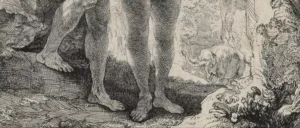
(detail).
Hansken liet haar sporen niet alleen achter in kunstwerken. In 1647 is ze op de dijk langs de Amstel, net buiten de stad, door een houten brug gezakt en in het water terechtgekomen – met goede afloop. Een kort gedichtje, ‘De Olifantsbrug’ van de zeventiende-eeuwse dichter Jan Six van Chandelier, gaat daarover. De brug werd hersteld, maar nu van steen gebouwd en sindsdien de Olifantsbrug genoemd. In de buurt liep ook het Olifantspad en er was een herberg die De Oliphant heette.
Hansken’s journey through Europe
How did Hansken actually wind up in Europe, and what happened to her? The initial impulse for her arrival came from Stadholder Frederik Hendrik, who was keenly interested in the territories colonized by the VOC. And so he requested several times that the VOC send him exotic animals, including an elephant. After the first ship carrying an elephant sank in 1629, a second ship arrived in Amsterdam in 1633. On board was the three-year-old Hansken, an elephant from Ceylon. She was placed in the country estate of Frederik Hendrik, Huis ter Nieuburg in Rijswijk. A few years later she was sold to Cornelis van Groenevelt, who would subsequently lead her through Europe for nearly twenty years. Pamphlets summoned the public to attend a presentation – Hansken was the prototype of later circus animals. Her life was short: owing to ignorance, she did not receive appropriate feed or care. She died, at the age of only 25 years, during a performance in Florence. Artist Stefano della Bella was present at the moment and captured the dead elephant in a pair of moving drawings. In collaboration with ARTIS, the IFAW and the Marjo Hoedemaker Elephant Foundation, Hansken, Rembrandt’s Elephant also incorporates a present-day perspective on elephant welfare in the seventeenth century and today
Activities for Young and Old, and The Book on Hansken
The exhibition also features a dedicated children’s route with activities for children from 6 to 12 years old. Learn to draw elephants like Rembrandt did, follow Hansken’s journey from Ceylon to Amsterdam, and put her skeleton back together. Learn all about Asian Elephants; what do you think Hansken’s life was like? The exhibition invites adults and children to join the discussion on these issues. In addition, The Rembrandt House Museum will present workshops for adults and children, ARTIS Academy is organizing a lecture and tour in the zoo and drawing workshops by the elephant enclosure by docents of ARTIS Ateliers, and the Vrije Academie is presenting talks on the exhibition. In the museum shop, the book about Hansken is available (in Dutch and in English): Rembrandt’s Elephant. The Story of Hansken, written by guest curator Michiel Roscam Abbing. And finally, Hansken is also going online! On 12 May, The Rembrandt House Museum will launch a talk show and podcast on the exhibitions on YouTube and Facebook. ‘Hansken, Rembrandts olifant’ is based on a concept of Michiel Roscam Abbing (Guest Curator and author of ‘Rembrandt’s Elephant. The Story of Hansken’) and Anneke Groen (concept developer). The exhibition was made in collaboration with ARTIS, the IFAW and the Marjo Hoedemaker Elephant Foundation, and made possible in part by the Prins Bernhard Cultuurfonds, Fonds 21, Stichting Zabawas, the Turing Foundation, the Gravin Van Bylandt Stichting, the P.W. Janssen’s Friesche Stichting and an anonymous fund.






